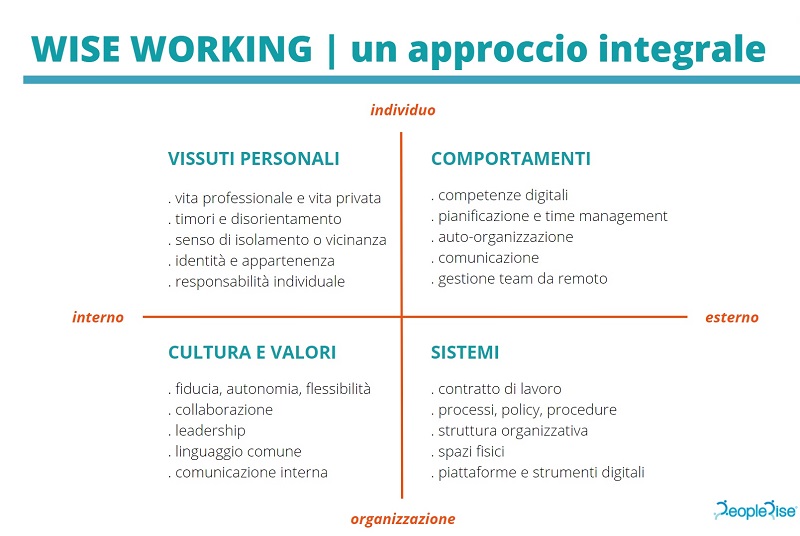When we talk about smart working, the conversation often revolves around topics such as digitization, hardware and software support, and the various possible contractual forms. However, we believe that the conversation cannot stop there. What can we do to avoid losing important pieces along the way?
What is the blind spot?
I’ll be honest. This expression is not entirely my own creation. “La zona cieca” (The blind spot) is the title of a novel by Chiara Gamberale, an author for whom I have a certain sympathy and affinity. I was at the beach, by the sea, when I read the book and this concept kept buzzing in my head for a few weeks.
For me, the blind spot represents everything that, for all sorts of reasons, we struggle to look at and see. Aspects of reality that we miss, on which we find it difficult to shed light. The same aspects that, because we haven’t considered them, come back knocking at our door several months later with unexpected consequences.
In this period we are working a lot on the implementation of new organizational models and practices related to Smart Working. To do so, we’ve found a perspective called Wise Working particularly useful. A wise approach to work takes a systemic perspective, one that recognizes the interdependence of all stakeholders and acknowledges personal, organizational, social and environmental experiences and needs as equally important.
After the crisis
In the past few months, many organizations have found themselves implementing a number of novelties: remote working, onsite working and smart working have alternated in new ways and processes. These have often been extraordinary measures, a series of exceptions and innovations dictated by the urgency of the moment.
For many, now is the time to address these changes with greater depth, questioning what to keep, what to let go of and what to transform from the existing organizational models.

Photo by Nonsap Visuals on Unsplash
Eyes to look
Our invitation is to devote the right care and attention to look at your own system and the areas of innovation that lay ahead.
We rarely find it useful to give pre-packaged solutions that are suitable for everyone. What we like to do is to suggest the eyes to look through, lenses to observe the reality. We are inspired by the four-quadrant model, proposed by Integral Coaching, and we have integrated and deepened it based on the experiences we have had in recent months with our clients.
The integral approach reminds us how important it is to look at organizations with a 360° perspective and, through its coordinates, it helps us uncover our blind spot. To look at what we are at risk of forgetting.
Sometimes it will be a specific quadrant that will elude us, other times we will struggle to focus on the right or the left, the top or the bottom.
Here’s an example. Let’s think about when it’s the right side, linked to the outside, that remains in the shadows. This is the case of those who are driven by the desire of promoting important mindset changes, but only act on internal aspects, related to the psychological and cultural sphere, forgetting about operativeness and concreteness. It is therefore essential to also take into account the lower right quadrant, because without an infrastructure and procedures that are consistent with the declared values, it will be difficult to observe the desired behaviors.
On the other hand, there are organizations that by their nature are more focused on the macro aspects of the two lower quadrants, those linked to the collective dimension of the organization. Projects of this type work on large groups and pay little attention to the individual dimension and the personal contribution that each person can make. This may be the case for large firms that, given the number of employees, are not always able to devote the same care to collective and individual aspects.
An illuminated smart working
We work in an uncertain and complex world where organizations are looking for new ways to unleash all their wisdom and innovative power, and smart working is one of them. Taking an integral approach allows us to maintain a 360° perspective and shed light on where we are not looking but where, most likely, our next step of development lies.
If we look inwards:
What are the implications of smart working on people’s well-being? What mindset change is desirable at the individual level? How do the meaning and role of leadership evolve in smart working? How do flexibility and autonomy interact with the pre-existing system of corporate values?
And then externally:
For what skills is there a need for training at the individual level? What are the new best practices that are becoming widespread at the behavioral level? How do you manage physically distant teams? How do you set up effective online meetings? What new policies can regulate smart working?
Our invitation is to keep the eyes open, and look with honesty and courage at our blind spots, aware that only by illuminating them we can implement deep-rooted transformations with long-lasting effects.

